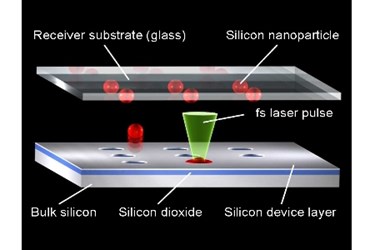Perfect Nanospheres Using Ultrashort Laser Pulses

The Nanophotonics Group of the Laser Zentrum Hannover e.V. (LZH) has developed a method to print nanoparticles made of different materials with controlled, reproducible sizes and to precisely deposit these particles on a receiver substrate. As a result, for the first time, the scientists succeeded in generating and positioning perfectly round silicon nanoparticles with a diameter of 165 nm. This method was presented in the March 4th issue of Nature Communications.
For the first time, scientists at the LZH were able to fabricate perfectly round silicon nanoparticles with a diameter of 165 nm and to arrange them in ordered structures. This was achieved with their newly developed method that was published in the March 4th issue of Nature Communications. This novel method uses ultrashort laser pulses to print nanoparticles with sizes in the two to three digit nanometer range made of different materials, such as metals, semiconductors and dielectrics. Afterwards, these nanoparticles can be precisely deposited on a receiver substrate.

Nanoparticles exhibit the unique optical property to scatter only light of a particular wavelength. Irradiated with white light and depending on their size, shape and on the interaction with their environment, they appear in a certain color. Therefore, they can be used for various applications in medicine and sensor technology.
Particle formation through surface tension
The starting point for the fabrication process is a thin layer of the material of which the nanoparticles shall be made. This layer is irradiated and molten using a single ultrashort laser pulse. Owing to the surface tension of the molten material, a nanosphere is formed which moves up and is finally captured by the receiver substrate. The position of the particles on the receiver material can be controlled very precisely.
Accurate and controllable
„This novel method is the first that allows for both fabricating and precisely depositing nanoparticles of a certain size”, explains Prof. Dr. Boris Chichkov, head of the Nanotechnology Department. “In this respect, our method is far superior to chemical processes which can produce large quantities of nanoparticles but not place them at the desired position.” With this method, two- or three-dimensionally arranged particle structures, such as nanoantennas, nanolasers and metamaterials, can be generated.
From the amorphous to the crystalline phase with the second pulse
The fabrication of silicon nanoparticles of a certain size is particularly interesting because of their special optical properties: They mainly scatter the visible light strongly, and besides the electrical field they also react to the magnetic field component. Other materials, however, almost exclusively interact with the electrical field only. According to the Mie theory, the magnetic light is scattered here, too. After printing, the fabricated silicon particles are in amorphous phase and can be transformed into the crystalline phase with a second laser pulse.
„The results have already lead to the emergence of silicon nanophotonics as a new research field of worldwide interest”, says Chichkov. "Therefore, the new method will certainly find many new applications.
The investigations were carried out within the scope of the SPP 1391 “Ultrafast Nanooptics” priority program and the collaborative research center “Transregio 123 – Planar Optronic Systems” (PlanOS). Both programs are funded by the German Research Foundation(DFG).
About Laser Zentrum Hannover e.V. (LZH)
As an independent, non-profit research institute, the Laser Zentrum Hannover e.V. (LZH) stands for innovative research, development and consulting. The LZH is supported by the Lower Saxony Ministry for Economics, Labour and Transport and is dedicated to the selfless promotion of applied research in the field of photonics and laser technology. Founded in 1986, over 170 staff have achieved a turnover of 15.993 million euros (for 2013), among others, from income from federal, state, EU and industrial projects.
The focus of the LZH lies on the fields of optical components and systems, optical production technologies, and biomedical photonics. Interdisciplinary cooperation between natural scientists and mechanical engineers makes innovative approaches to challenges from the most different areas possible: from the development of components for specific laser systems to process developments for the most diverse laser applications, for example for medical technology or lightweight construction in the automotive sector. Seventeen spin off companies have emerged from the LZH up to now. Thus, the LZH has created a strong transfer between fundamental science, application oriented research, and industry.
Source: Laser Zentrum Hannover e.V. (LZH)
